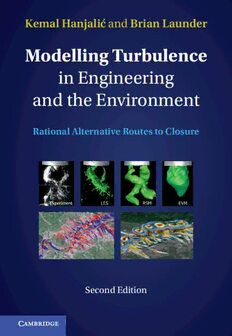Table Of ContentMODELLING TURBULENCE IN ENGINEERING
AND THE ENVIRONMENT
RationalAlternativeRoutestoClosure
Modelling transport and mixing by turbulence in complex flows are huge challenges
for computational fluid dynamics (CFD). This highly readable book introduces readers
to modelling levels that respect the physical complexity of turbulent flows. It examines
thehierarchyofReynolds-averagedNavier–Stokes(RANS)closuresinvarioussituations
rangingfromfundamentalflowstothree-dimensionalindustrialandenvironmentalappli-
cations.Thegeneralsecond-momentclosureissimplifiedtolineareddy-viscositymodels,
demonstratinghowtoassesstheapplicabilityofsimplerschemesandtheconditionsunder
whichtheygivesatisfactorypredictions.
Theprincipalchangesforthesecondeditionreflecttheimpactofcomputingpower:a
newchapterdevotedtounsteadyRANSandanotheronhowlarge-eddysimulation,LES,
andRANSstrategiescanbeeffectivelycombinedforparticularapplications.
This book will remain the standard for those in industry and academia seeking expert
guidanceonthemodellingoptionsavailable,andforgraduatestudentsinphysics,applied
mathematicsandengineeringenteringtheworldofturbulentflowCFD.
KEMAL HANJALIC´ isProfessorEmeritusattheDelftUniversityofTechnologyandan
internationalfellowoftheUK’sRoyalAcademyofEngineeringandtheRussianAcademy
ofScience.Hisinnovativeandsustainedcontributionstoturbulence-modeldevelopment,
includingheattransferandenvironmentalflows,havebeenrecognizedbytheMaxPlanck
andNusselt–ReynoldsResearchPrizes.
BRIAN LAUNDER, Emeritus Professor at the University of Manchester, has enjoyed
morethanahalf-centuryofturbulence-modellingprojectswithhisco-author.Widelycited
for his two-equation eddy-viscosity modelling, his main focus has been stress-transport
andnon-lineareddy-viscosityclosures.HewaselectedFRSandFREngforhisturbulence
researchwithhonorarydoctoratesfromthreeEuropeanuniversities.
Published online by Cambridge University Press
Published online by Cambridge University Press
MODELLING TURBULENCE IN
ENGINEERING AND THE
ENVIRONMENT
Rational Alternative Routes to Closure
Second Edition
´
KEMAL HANJALIC and BRIAN LAUNDER
DelftUniversityofTechnology UniversityofManchester
Chapter10co-authoredwith
ALISTAIR J. REVELL
UniversityofManchester
Published online by Cambridge University Press
UniversityPrintingHouse,CambridgeCB28BS,UnitedKingdom
OneLibertyPlaza,20thFloor,NewYork,NY10006,USA
477WilliamstownRoad,PortMelbourne,VIC3207,Australia
314–321,3rdFloor,Plot3,SplendorForum,JasolaDistrictCentre,NewDelhi–110025,India
103PenangRoad,#05–06/07,VisioncrestCommercial,Singapore238467
CambridgeUniversityPressispartoftheUniversityofCambridge.
ItfurtherstheUniversity’smissionbydisseminatingknowledgeinthepursuitof
education,learning,andresearchatthehighestinternationallevelsofexcellence.
www.cambridge.org
Informationonthistitle:www.cambridge.org/9781108835060
DOI:10.1017/9781108875400
©KemalHanjalic´andBrianLaunder2011,2023
Thispublicationisincopyright.Subjecttostatutoryexception
andtotheprovisionsofrelevantcollectivelicensingagreements,
noreproductionofanypartmaytakeplacewithoutthewritten
permissionofCambridgeUniversityPress.
Firstpublished2011
Secondedition2023
PrintedintheUnitedKingdombyTJBooksLimited,PadstowCornwall
AcataloguerecordforthispublicationisavailablefromtheBritishLibrary.
LibraryofCongressCataloging-in-PublicationData
Names:Hanjalic´,Kemal,author.|Launder,B.E.(BrianEdward),author.
Title:Modellingturbulenceinengineeringandtheenvironment:rationalalternativeroutestoclosure/
KemalHanjalic´,TechnischeUniversiteitDelft,TheNetherlandsandBrianLaunder,Universityof
Manchester;Chapter10co-authoredbyAlistairRevell,UniversityofManchester.
Description:Secondedition.|Cambridge,UnitedKingdom;NewYork,NY:CambridgeUniversity
Press,2022.|Includesbibliographicalreferencesandindex.
Identifiers:LCCN2021059599(print)|LCCN2021059600(ebook)|ISBN9781108835060(hardback)|
ISBN9781108875400(ebook)
Subjects:LCSH:Turbulence–Mathematicalmodels.|BISAC:SCIENCE/Mechanics/Fluids
Classification:LCCTA357.5.T87H3672022(print)|LCCTA357.5.T87(ebook)|DDC
532/.0527–dc23/eng/20220217
LCrecordavailableathttps://lccn.loc.gov/2021059599
LCebookrecordavailableathttps://lccn.loc.gov/2021059600
ISBN978-1-108-83506-0Hardback
CambridgeUniversityPresshasnoresponsibilityforthepersistenceoraccuracyof
URLsforexternalorthird-partyinternetwebsitesreferredtointhispublication
anddoesnotguaranteethatanycontentonsuchwebsitesis,orwillremain,
accurateorappropriate.
Published online by Cambridge University Press
Contents
Preface pageix
PrefacetotheFirstEdition xiii
PrincipalNomenclature xvii
1 Introduction 1
1.1 Thefactofturbulentflow 1
1.2 Broadoptionsinmodelling 2
1.3 A preview of the mean-strain generation processes in the
stress-transportequation 5
1.4 Some consequences of the no-slip boundary condition at a
wall 9
1.5 Sequencingofthematerial 11
2 Theexactequations 13
2.1 Theunderpinningconservationequations 13
2.2 TheReynoldsequations 15
2.3 Thesecond-momentequations 22
3 Characterizationofstressandfluxdynamics:elementsrequired
formodelling 33
3.1 Introduction 33
3.2 Energyflowprocessesinturbulence 33
3.3 Thespectralcharacterofturbulence 38
3.4 Theε-equation 43
3.5 Transport equation for the mean-square scalar variance,
θ2 46
3.6 Transportequationfordissipationofscalarvariance,εθθ 48
3.7 Turbulenceanisotropy,invariantsandrealizability 50
v
Published online by Cambridge University Press
vi Contents
4 Approachestoclosure 59
4.1 Generalremarksandbasicguidelines 59
4.2 Pressureinteractions,Φij andΦθj:thePoissonequation 62
4.3 The basic second-moment closure for high-Re flow
t
regions 66
4.4 Pressure-strainmodelsfromtensorexpansion 84
4.5 Turbulenceaffectedbyforcefields 111
4.6 Modellingthetriplemoments 131
5 Modellingthescale-determiningequations 140
5.1 Theenergydissipationrate,ε 140
5.2 Otherscale-determiningequations 152
5.3 Multi-scaleapproaches 157
5.4 Determiningεθθ,thedissipationrateofθ2 163
6 ModellingintheimmediatewallvicinityandatlowRe 167
t
6.1 The nature of viscous and wall effects: options for
modelling 167
6.2 Thestructureofthenear-wallsublayer 170
6.3 Wallintegration(WIN)schemes 185
6.4 Illustrationoftheperformanceoftwonear-wallmodels 208
6.5 Ellipticrelaxationconcept 222
7 Simplifiedschemes 233
7.1 Rationaleandorganization 233
7.2 Reducedtransport-equationmodels 234
7.3 Algebraictruncationsofthesecond-momentequations 239
7.4 Lineareddy-viscositymodels 261
8 Wallfunctions 293
8.1 Earlyproposals 293
8.2 Towards a generalization of the wall-function concept:
preliminaries 299
8.3 Analyticalwallfunctions(AWFs) 302
8.4 AsimplifiedAWF(SAWF) 312
8.5 Blendedwalltreatment(BWT) 319
8.6 Numericalwallfunctions(NWFs) 327
9 RANSmodellingofunsteadyflows(URANS) 332
9.1 Feasibility of URANS for inherently unsteady turbulent
flows 332
Published online by Cambridge University Press
Contents vii
9.2 Mathematicalformalism 334
9.3 The role of the URANS model: EVM versus RSM in flow
overacylinder 337
9.4 URANS modelling of swirling flows and vortex
precessing 348
9.5 CapabilitiesofEVMsandASM/AFMswithinURANS 353
10 HybridRANS-LES(HRL) 371
Co-authoredwithAlistairJ.Revell
10.1 Introductionandoverview 371
10.2 Large-eddysimulation 381
10.3 Theclassificationofhybridmethods 396
10.4 BulkzonalmodelsandembeddedLES 402
10.5 Wall-modelledLES 406
10.6 Seamlessmethods 426
10.7 HybridRANS-LESmodels:summaryandoutlook 459
References 464
Index 498
Published online by Cambridge University Press
Published online by Cambridge University Press
Preface
Over the decade since the first edition of Modelling Turbulence in Engineering
and the Environment made its appearance, the wider topic of computational fluid
dynamics–orCFDasitisnowuniversallyknown–hasbecomeevenmorefirmly
establishedastheroutetoresolvingimportantandpossiblychallengingquestions
of fluid motion in the turbulent flow regime. As the reader may judge from the
Preface to that first edition (which follows), our view was that the progressive
shift, then underway, from using the Reynolds-averaged Navier–Stokes (RANS)
equationsasthebasisforaccountingforturbulenttransport(so-calledRANSmod-
elling)tolarge-eddysimulation(LES)wasnotassuredlythepreferredpracticefor
manyapplications.
The notion that, to improve the reliability of one’s CFD computations, one
needed to upgrade the modelling strategy from a RANS-based closure to LES
largely arose from the presumption that RANS-based modelling was invariably
associatedwiththeuseofalineareddy-viscosityapproximation.Thatpresumption
we emphatically rejected. Our emphasis in the first edition was rather at a closure
level where turbulent momentum, heat and mass fluxes were found not from such
quasi-laminarconstitutiveconceptsbutratherbyapproximationoftheirowntrans-
port equations, a path formally known as ‘second-moment closure’. Indeed, the
subheadingtothebook’stitlewasSecond-MomentRoutestoClosure.Thisoverall
philosophyisonethatweretaininthepresentedition,though,forreasonsthatwill
shortlybecomeclear,thesubtitlehasbeenchangedtorecognizethebroaderrange
ofmodellingnowincluded.
Itisnotarguedthatsecond-momentclosureisalwaysthebestRANSapproach
to follow, however. In simple shear flows where turbulence transport is small,
second-momentclosuresamounttowhatistantamounttoaneddy-viscositymodel
(EVM) of turbulence. There are then clear advantages to making simplifications
to the physical model in order to achieve major savings in computational time,
whether from solving fewer equations or from faster rates of convergence – or,
ix
https://doi.org/10.1017/9781108875400.001 Published online by Cambridge University Press

